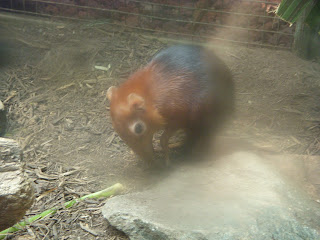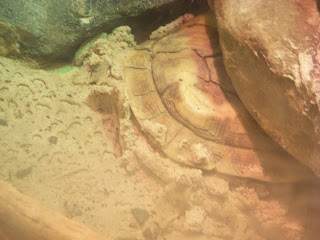This appears to be quickly becoming Albertonykus's Zoo Trip Blog. With luck I should have other material up in the not-too-distant future, but it so happens that I've gone on quite a few zoo trips over the past few months so bear with the glut for now.
Another zoo I went to this summer was the National Zoological Park in Washington, D.C. Being part of the Smithsonian Institution, admission is entirely free (yes, free), with the flip side of the coin being that you have to pay $2 if you want a zoo map. But really, I think I'd rather focus on the thought that I get to visit such a prestigious institution at essentially no cost at all.
(Amusing tangent not related to my zoo visit: I was chatting with a friend while typing up this post, and he happened to bring up Death Eaters in our conversation, causing me to accidentally type that you have to "pay death" in order to obtain a zoo map.)
The outdoor exhibits at the National Zoo are fairly impressive, but I was most struck by its indoor collections. I first headed for the Small Mammal House, because I'd heard good things about it and it was fairly close to where I entered the zoo. And also because, much to the disgrace of dinosaur fans worldwide, I'm quite fond of some small mammals.
Unexpectedly, the first thing I was rewarded with in the Small Mammal House was a dinosaur rather than a mammal. This is a Von der Decken's hornbill, and I don't think I'd ever seen one before. What it was doing in the Small Mammal House is beyond me, but it was a pleasant surprise.
Rock hyraxes doing what hyraxes do.
A prehensile-tailed porcupine.
A rock cavy, actually closer to capybaras than to true cavies (such as guinea pigs).
A three-banded armadillo, the only armadillos that can actually roll themselves up into a perfect ball. Armadillos are lots of fun to watch when they're awake. One might liken them to "mammalian turtles" in terms of appearance, but their active scurrying is far from what one would expect from something so heavily armored.
There was a fairly large exhibit shared by golden lion tamarins, pale-faced sakis, acouchis, two-toed sloths, three-banded armadillos, and yet another theropod representative, this elegant-crested tinamou.
A pale-faced saki from said exhibit.
More signs of dinosaurian takeover, a pair of burrowing owls.
A black and rufous elephant shrew. This and the short-eared elephant shrew from an earlier exhibit (which I couldn't get any pictures of because it was hidden in a rock crevice) are my first elephant shrews. Such a mixture of weirdness and adorable these are. In spite of their name, probably no one seriously thought elephant shrews were closely related to elephants (instead they were believed to be, well, shrews), but molecular studies have suggested they're afrotheres, the same group that includes elephants, hyraxes, sireneans, aardvarks, golden moles, and tenrecs. Irony! There are lots of interesting things about elephant shrews that I can talk about, such as the fact that they construct a wide network of paths which they take pains to keep unobstructed. They have an uncanny memory of the paths they make, allowing quick escape from predators. The young are extremely precocial, capable of feeding on some solid food in as little as five days after being born. Part of me prefers their alternate name, sengi.
A black-footed ferret lying around in a spot not conducive to visitor viewing. I was somewhat amused by the fact that the zoo actually had to put up signs informing visitors that animals hide, and aren't always out in plain sight when you want them to be.
A Prevost's squirrel, a very large and brightly colored squirrel from tropical forests in Asia.
Next I went over to the Reptile Discovery Center (i.e.: the reptile house). Once again I saw many species I'd never seen, and for some reason or another the reptiles were more active than I'd seen at any other zoo.
These are chameleon forest dragons, a species I'd never even heard of before my visit. Incidentally, some people really do need their reading comprehension checked. The sign says "chameleon forest dragon", not "chameleon". Otherwise a tiger shark would be a tiger, a tree shrew would be a tree, and a Nile crocodile would be the entire Nile River.
An Everglades rat snake.
A tortoise, oddly known as the impressed tortoise.
A pancake tortoise, demonstrating the utility of its really flat shell by hiding underneath a rock.
A gharial. Finally!
A Fiji banded iguana.
A crocodile newt. When caught, it stimulates its poison glands by stabbing them with its ribs.
A coati in an outdoor exhibit. Nearby were displays for caracals (which I didn't see), lions, and tigers.
One of the zoo's highlights is their great focus on displaying much of the research and conservation they do. For instance, I visited the Think Tank, which has displays on new discoveries about animal intelligence and exhibits animals such as orangutans, Sulawesi macaques, and rats. The orangutans have a large transport system, namely a set of thick wires suspended high above zoo grounds, which allows them to travel freely between the Think Tank and their other exhibit at the Great Ape House.
The zoo's Amazon building, Amazonia, had two stories, the first mostly showcasing Amazonian fish and turtles, as well as a few arthropods in terrariums. The larger tanks were directly connected to the upper level, which was an elaborate rainforest walkthrough with free-roaming animals. Having experienced a similar exhibit at the Vancouver Aquarium, I enjoy such displays quite a lot, as you really have to stick around for a bit to find a good number of animals.
Among those I saw was this blue-gray tanager.
And this red-crested cardinal.
I also saw titi monkeys, roseate spoonbills, and sunbitterns. There are red-footed tortoises, two-toed sloths, poison-dart frogs, and toads in the exhibit as well, but I have my doubts about whether it's even possible to locate the anurans in there. After the rainforest walkthrough was a more dedicated amphibian display area, focusing especially on the global amphibian crisis (again reminding me of the Vancouver Aquarium, which has a similar exhibit).
Just like with the other zoo buildings, I enjoyed the Bird House tremendously. I saw many species that I'd never- Guess I'm just getting repetitive now. These are guira cuckoos, a very peculiar-looking cuckoo species that I remember best for being the main inspiration behind the Archaeopteryx restorations by Deviant Art member SageKorppi.
A keel-billed toucan with a green iguana. Go diapsids!
A Guam kingfisher. Yes, these are extinct in the wild (having been decimated by the invasive brown tree snake).
Another bird species extinct in the wild, the Socorro dove. In case it's not clear by now, you get to see bird species that are extinct in the wild for free at the National Zoo. If you're anywhere in the vicinity, go to the National Zoo.
A boat-billed heron.
A pheasant pigeon. It's a pigeon that looks and acts like a pheasant.
Sadly, it appears that kiwis hate me, because once again I didn't get to see kiwis. At least I can say that I tried to find them rather than not being given a chance to do so at all due to exhibit maintenance or some such.
I appear to have been a little stingy with photography, perhaps out of fear that my camera battery would run out prematurely like it did on my Taipei Zoo trip. Fear not, for I went on a second trip to the National Zoo not too long ago and came back with a much greater bounty of photos.
Friday, October 12, 2012
Subscribe to:
Post Comments (Atom)





































Kiwis hate you? I get the same thing - I never saw them when we went to San Diego, even though we thoroughly searched their exhibit.
ReplyDeleteAt least you got to search for them there. As noted in my San Diego Zoo posts, on both of my trips there the entire exhibit was down for maintenance!
DeleteYou're rankled my appetite...
ReplyDeleteYep, chameleon forest dragons are real creatures..
ReplyDeletehttps://en.wikipedia.org/wiki/Gonocephalus_chamaeleontinus